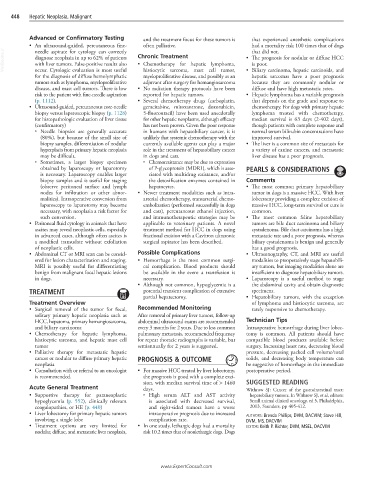Page 917 - Cote clinical veterinary advisor dogs and cats 4th
P. 917
448 Hepatic Neoplasia, Malignant
Advanced or Confirmatory Testing and the treatment focus for these tumors is that experienced anesthetic complications
• An ultrasound-guided, percutaneous fine- often palliative. had a mortality risk 100 times that of dogs
VetBooks.ir diagnose neoplasia in up to 62% of patients Chronic Treatment • The prognosis for nodular or diffuse HCC
that did not.
needle aspirate for cytology can correctly
is poor.
with liver tumors. False-positive results also
• Chemotherapy for hepatic lymphoma,
occur. Cytologic evaluation is most useful
for the diagnosis of diffuse hemolymphatic histiocytic sarcoma, mast cell tumor, • Biliary carcinoma, hepatic carcinoids, and
hepatic sarcomas have a poor prognosis
myeloproliferative disease, and possibly as an
tumors such as lymphoma, myeloproliferative adjuvant after surgery for hemangiosarcoma because they are commonly nodular or
disease, and mast cell tumors. There is low • No radiation therapy protocols have been diffuse and have high metastatic rates.
risk to the patient with fine-needle aspiration reported for hepatic tumors. • Hepatic lymphoma has a variable prognosis
(p. 1112). • Several chemotherapy drugs (carboplatin, that depends on the grade and response to
• Ultrasound-guided, percutaneous core-needle gemcitabine, mitoxantrone, doxorubicin, chemotherapy. For dogs with primary hepatic
biopsy versus laparoscopic biopsy (p. 1128) 5-fluorouracil) have been used anecdotally lymphoma treated with chemotherapy,
for histopathologic evaluation of liver tissue for other hepatic neoplasms, although efficacy median survival is 63 days (2-402 days),
(confirmatory) has not been proven. Given the poor response though patients with complete response and
○ Needle biopsies are generally accurate in humans with hepatobiliary cancer, it is normal serum bilirubin concentrations have
(80%), but because of the small size of unlikely that systemic chemotherapy with the improved survival.
biopsy samples, differentiation of nodular currently available agents can play a major • The liver is a common site of metastasis for
hyperplasia from primary hepatic neoplasia role in the treatment of hepatobiliary cancer a variety of canine cancers, and metastatic
may be difficult. in dogs and cats. liver disease has a poor prognosis.
○ Sometimes, a larger biopsy specimen ○ Chemoresistance may be due to expression
obtained by laparoscopy or laparotomy of P-glycoprotein (MDR1), which is asso- PEARLS & CONSIDERATIONS
is necessary. Laparoscopy enables larger ciated with multidrug resistance, and/or
biopsy samples and is useful for staging the detoxification enzymes contained in Comments
(observe peritoneal surface and lymph hepatocytes. • The most common primary hepatobiliary
nodes for infiltration or other abnor- • Newer treatment modalities such as intra- tumor in dogs is a massive HCC. With liver
malities). Intraoperative conversion from arterial chemotherapy, transarterial chemo- lobectomy providing a complete excision of
laparoscopy to laparotomy may become embolization (performed successfully in dogs massive HCC, long-term survival or cure is
necessary, with neoplasia a risk factor for and cats), percutaneous ethanol injection, common.
such conversion. and immunotherapeutic strategies may be • The most common feline hepatobiliary
• Peritoneal fluid cytology in animals that have applicable to veterinary patients. A novel tumors are bile duct carcinoma and biliary
ascites may reveal neoplastic cells, especially treatment method for HCC in dogs using cystadenoma. Bile duct carcinoma has a high
in advanced cases, although often ascites is fractional excision with a Cavitron ultrasonic metastatic rate and a poor prognosis, whereas
a modified transudate without exfoliation surgical aspirator has been described. biliary cystadenoma is benign and generally
of neoplastic cells. has a good prognosis.
• Abdominal CT or MRI scan can be consid- Possible Complications • Ultrasonography, CT, and MRI are useful
ered for lesion characterization and staging. • Hemorrhage is the most common surgi- modalities to preoperatively stage hepatobili-
MRI is possibly useful for differentiating cal complication. Blood products should ary tumors, but imaging modalities alone are
benign from malignant focal hepatic lesions be available in the event a transfusion is insufficient to diagnose hepatobiliary tumors.
in dogs. necessary. • Laparoscopy is a useful method to stage
• Although not common, hypoglycemia is a the abdominal cavity and obtain diagnostic
TREATMENT potential transient complication of extensive specimens.
partial hepatectomy. • Hepatobiliary tumors, with the exception
Treatment Overview of lymphoma and histiocytic sarcoma, are
• Surgical removal of the tumor for focal, Recommended Monitoring rarely responsive to chemotherapy.
solitary primary hepatic neoplasia such as After removal of primary liver tumors, follow-up
HCC, hepatoma, primary hemangiosarcoma, abdominal ultrasound exams are recommended Technician Tips
and biliary carcinoma every 3 months for 2 years. Due to less common Intraoperative hemorrhage during liver lobec-
• Chemotherapy for hepatic lymphoma, pulmonary metastasis, recommended frequency tomy is common. All patients should have
histiocytic sarcoma, and hepatic mast cell for repeat thoracic radiographs is variable, but compatible blood products available before
tumor semiannually for 2 years is suggested. surgery. Increasing heart rate, decreasing blood
• Palliative therapy for metastatic hepatic pressure, decreasing packed cell volume/total
cancer or nodular to diffuse primary hepatic PROGNOSIS & OUTCOME solids, and decreasing body temperature can
neoplasia be suggestive of hemorrhage in the immediate
• Consultation with or referral to an oncologist • For massive HCC treated by liver lobectomy, postoperative period.
is recommended. the prognosis is good with a complete exci-
sion, with median survival time of > 1460 SUGGESTED READING
Acute General Treatment days. Withrow SJ: Cancer of the gastrointestinal tract:
• Supportive therapy for paraneoplastic ○ High serum ALT and AST activity hepatobiliary tumors. In Withrow SJ, et al, editors:
hypoglycemia (p. 552), clinically relevant is associated with decreased survival, Small animal clinical oncology, ed 5, Philadelphia,
coagulopathies, or HE (p. 440) and right-sided tumors have a worse 2013, Saunders, pp 405-412.
• Liver lobectomy for primary hepatic tumors intraoperative prognosis due to increased AUTHORS: Brenda Phillips, DVM, DACVIM; Steve Hill,
involving a single lobe complication rate. DVM, MS, DACVIM
• Treatment options are very limited for • In one study, lethargic dogs had a mortality EDITOR: Keith P. Richter, DVM, MSEL, DACVIM
nodular, diffuse, and metastatic liver neoplasia, risk 10.2 times that of nonlethargic dogs. Dogs
www.ExpertConsult.com

